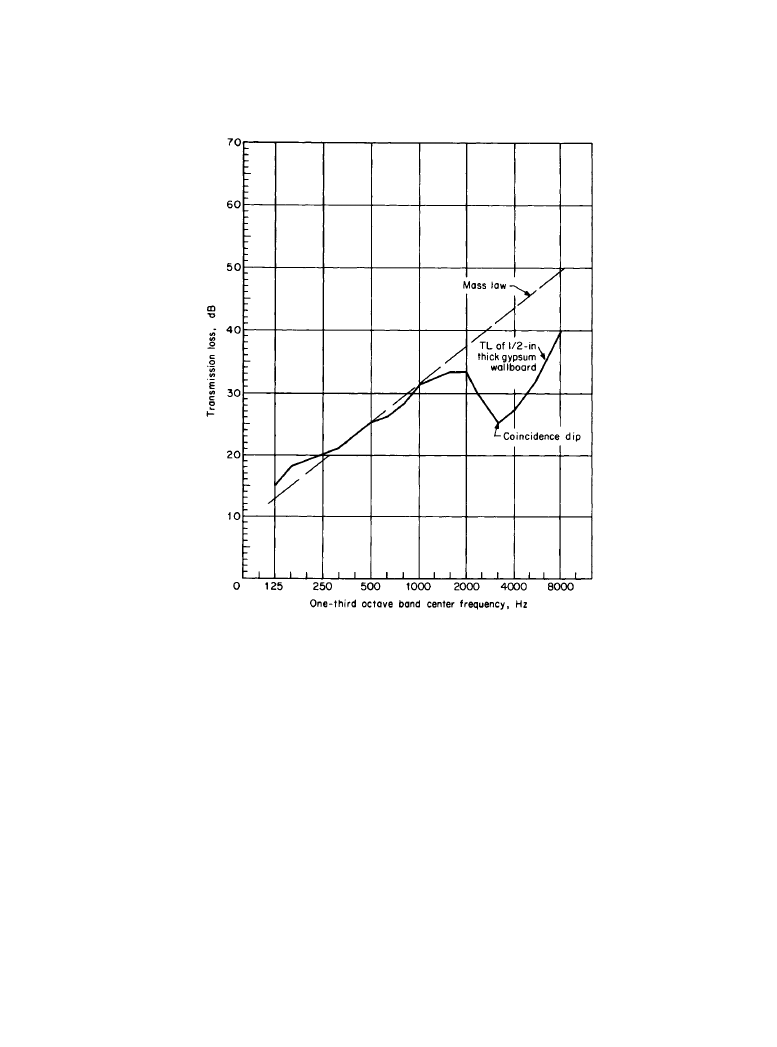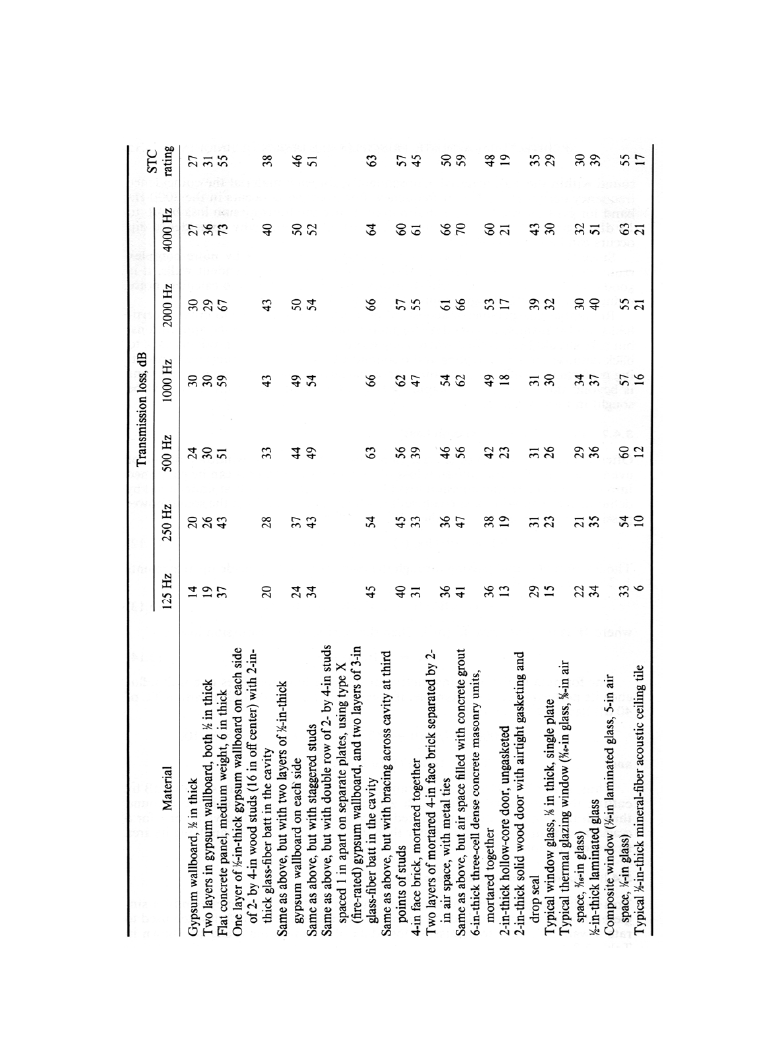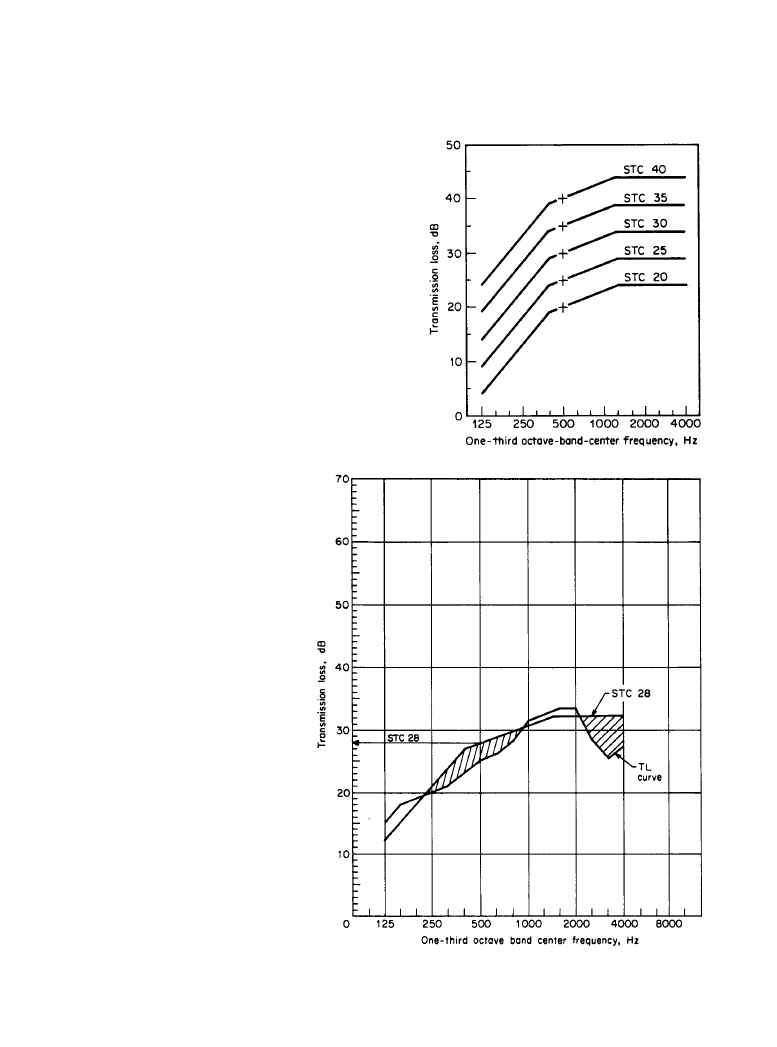ВУЗ: Казахская Национальная Академия Искусств им. Т. Жургенова
Категория: Книга
Дисциплина: Не указана
Добавлен: 03.02.2019
Просмотров: 21613
Скачиваний: 19

The Physical Nature of Sound 3-15
(3.1.9)
Where:
S = surface area of the common wall, ft (m)
A = total absorption of the receiving room, sabins (metric sabins)
In the other typical situation, in which the sound travels from a nonreverberant area to a rever-
berant space—for example, between a noisy highway and a studio—the noise reduction is 5 dB
less
(3.1.10)
The term 10 log (S/A) is often called room effect.
In general terms, the transmission loss of a single wall is governed by its mass
(3.1.11)
Where:
f = frequency, Hz
M = mass, lb/ft (kg/m)
K = 34 (48 for metric units)
This shows that every time that the mass of the wall is doubled, the transmission loss
increases by 6 dB. However, in practical terms the mass of a wall cannot be doubled more than a
few times before running into structural and space limitations. Also, Equation (3.1.11) shows
that the transmission loss increases by 6 dB each time that the frequency is doubled. Thus, at
high frequencies much more transmission loss is demonstrated than at bass frequencies.
Mass law essentially gives the maximum TL that can be expected from a homogenous wall. In
fact, lower values are to be expected primarily as a result of coincidence dip. The frequency at
which this dip occurs depends on the speed of sound within the wall material. Consequently, for
each material the coincidence frequency occurs at a different frequency. For example, it occurs in
the 2000-Hz band for gypsum wallboard. The dip may reduce the transmission loss by up to 15
dB. Figure 3.1.3 shows an example. Details of how and why coincidence dip occurs can be found
in [2].
Because the transmission loss can be changed or improved by more complex methods of con-
struction, perhaps incorporating double independent walls, it is good design practice to use certi-
fied transmission-loss test data to calculate noise reduction of specific design proposals [3].
Reputable salespersons of acoustical products should be able to provide certified sound-trans-
mission-loss data for their products used in specific applications, but care should be exercised
when using more than one of these products back to back because acoustic coupling and reso-
nances between the products make resulting performance difficult to predict. Because the devel-
opment of complex partitions is beyond the scope of this chapter, advice of an expert in acoustics
should be sought in these situations.
TL
NR
10 log S/A
(
)
+
=
TL
NR
10 log S/A
(
) 5
+
+
=
TL
20 log f
( ) 20 log M
( ) K
–
+
=
Downloaded from Digital Engineering Library @ McGraw-Hill (www.digitalengineeringlibrary.com)
Copyright © 2004 The McGraw-Hill Companies. All rights reserved.
Any use is subject to the Terms of Use as given at the website.
The Physical Nature of Sound

3-16 Architectural Acoustic Principles and Design Techniques
3.1.3f
Composite Transmission Loss
Often a wall is made up of several elements such as a wall, windows, doors, or even openings.
The transmission loss of each of these elements can be combined into one composite transmis-
sion loss (TL
c
). The procedure is best understood by defining a transmission-loss coefficient
τ
which is the fraction of the sound power passing through a unit area of the wall
(3.1.12)
The fraction of sound passing through the composite wall
τ
c
made up of elements 1, 2, ... n, is
then
(3.1.13)
TL
10 log
τ
( )
–
=
or
τ
10
TL/10
–
=
τ
c
τ
1
W
1
/W
τ
2
W
2
/W
τ
n
W
n
/W
+
+
=
Figure 3.1.3
Example of coincidence dip reducing transmission loss.
Downloaded from Digital Engineering Library @ McGraw-Hill (www.digitalengineeringlibrary.com)
Copyright © 2004 The McGraw-Hill Companies. All rights reserved.
Any use is subject to the Terms of Use as given at the website.
The Physical Nature of Sound

The Physical Nature of Sound 3-17
where W is the wall area, ft
2
(m
2
). Then the composite transmission loss is
(3.1.14)
The formula is also very instructive in showing how apertures in a wall influence its perfor-
mance. For example, if a wall with an area of 100 ft
2
with a TL of 40 dB has a 3-ft
2
hole, then
(3.1.14a)
and
(3.1.14b)
Thus, a 40-dB wall has had its transmission loss reduced from 40 to 15 dB by cutting the hole.
Small holes, such as cracks and slits, let much more sound through than the equations presented
above would predict. The value of
τ for a crack may be up to 10 times greater than would be pre-
dicted by applying its area to these equations.
3.1.3g
Sound Transmission Class
To simplify handling transmission-loss data in multiple-frequency bands, a single-number
descriptor, called the sound transmission class (STC), is often used to rate a wall. STC and trans-
mission-loss data of common materials are shown in Table 3.1.3.
However, in the process of condensing these multifrequency TL data, it is assumed that the
general shape of the noise spectrum is similar to that of speech. Nevertheless, in spite of this pro-
cess, STC ratings are often applied indiscriminately to the isolation of other types of sounds such
as machinery or music.
The STC of a transmission-loss spectrum is determined by adjusting a fixed-shape contour
over the plotted data according to the following predetermined criteria:
•
Only one-third-octave bands from 125 to 4000 Hz are considered
•
The sum of the deficiencies (the deviations below the contour) cannot exceed 32 dB
•
Values above the contour are ignored
•
The deficiency in any one band cannot exceed 8 dB
The STC rating is the ordinate of the contour at 500 Hz. Figure 3.1.4 shows the STC curves,
and Figure 3.1.5 shows an example.
Transmission-loss curves are typically jagged and are not smooth and rising like the standard-
ized STC curve. At the frequency where the STC curve may exceed the TL curve by up to 8 dB,
insufficient noise reduction may be obtained. In addition, since the STC rating incorporates little
transmission loss at low frequencies, it is most inappropriate to use STC ratings for the isolation
of bass sounds.
TL
c
10 log
τ
c
( )
–
=
τ
c
0.0001
97
100
---------
1 3
100
---------
or 3.0097/100
=
+
=
TL
c
10 log
100
3.0097
----------------
15dB
=
=
Downloaded from Digital Engineering Library @ McGraw-Hill (www.digitalengineeringlibrary.com)
Copyright © 2004 The McGraw-Hill Companies. All rights reserved.
Any use is subject to the Terms of Use as given at the website.
The Physical Nature of Sound

3-18 Architectural Acoustic Principles and Design Techniques
T
a
b
le 3.
1.
3 T
y
p
ic
a
l
S
T
C an
d
T
ra
n
s
m
is
si
on
-L
o
s
s Da
ta
Downloaded from Digital Engineering Library @ McGraw-Hill (www.digitalengineeringlibrary.com)
Copyright © 2004 The McGraw-Hill Companies. All rights reserved.
Any use is subject to the Terms of Use as given at the website.
The Physical Nature of Sound

The Physical Nature of Sound 3-19
Figure 3.1.4
Example of sound-transmission-
class (STC) curves. (
From ASTM specification
E 1413-73.)
Figure 3.1.5
Sound trans-
mission class (STC) for 1/2-
in-thick gypsum wallboard.
When a TL data point falls
below the STC curve, the
difference is termed a
defi-
ciency. The sum of all defi-
ciencies must not be
greater than 32 dB. No sin-
gle deficiency shall be
greater than 8 dB.
Downloaded from Digital Engineering Library @ McGraw-Hill (www.digitalengineeringlibrary.com)
Copyright © 2004 The McGraw-Hill Companies. All rights reserved.
Any use is subject to the Terms of Use as given at the website.
The Physical Nature of Sound